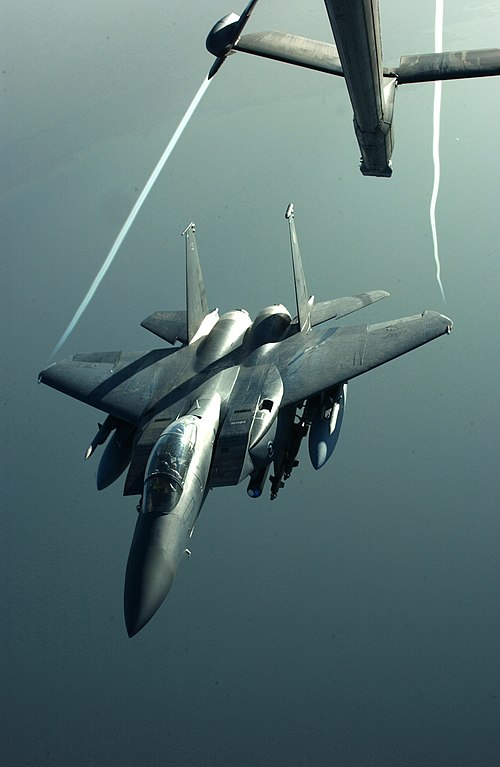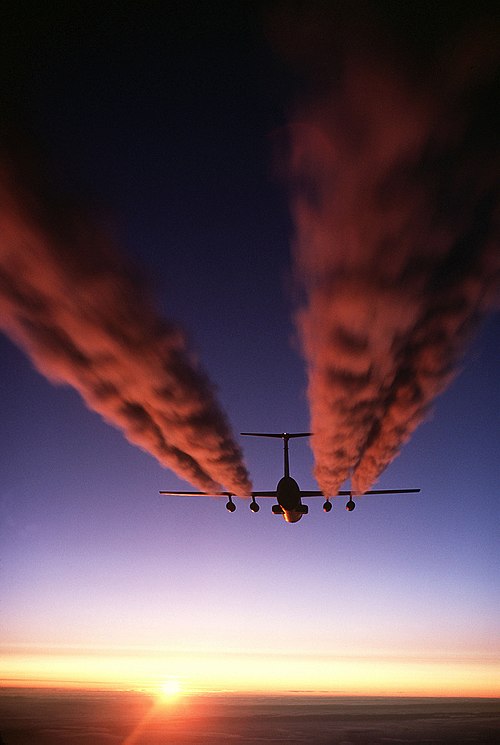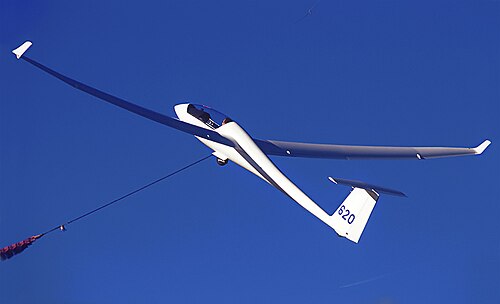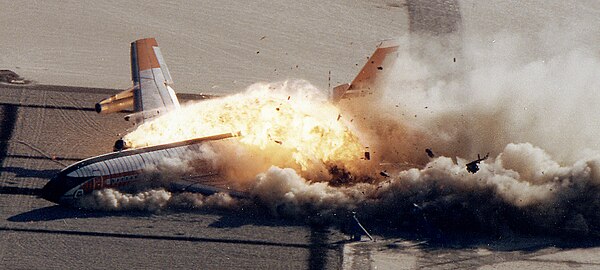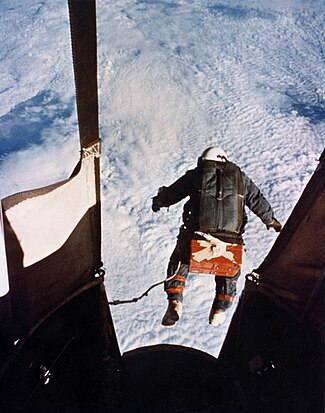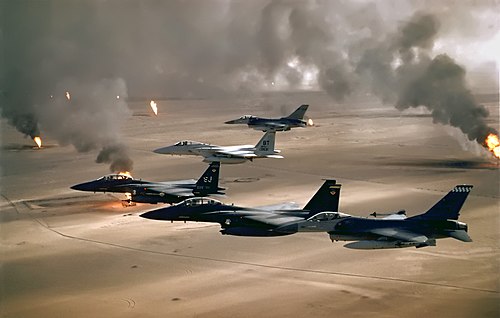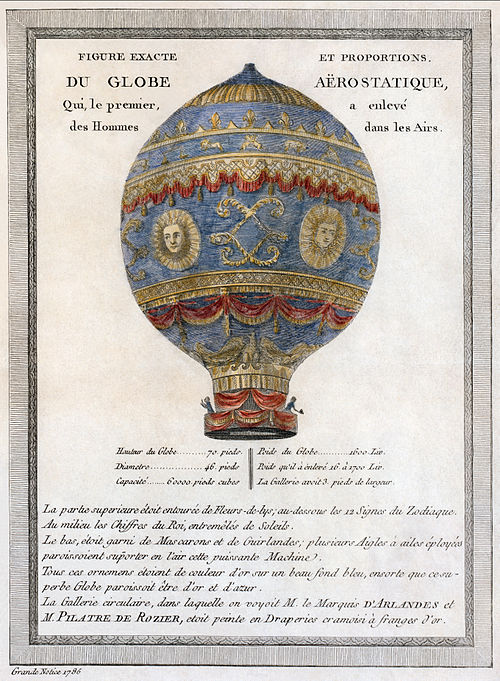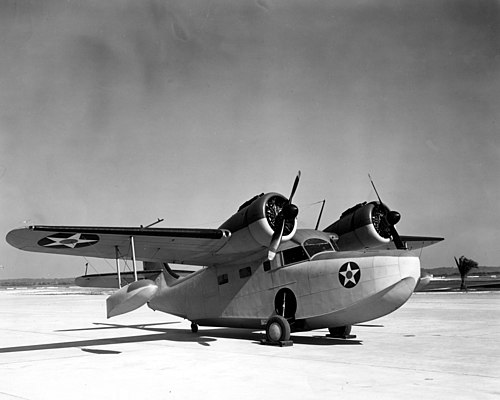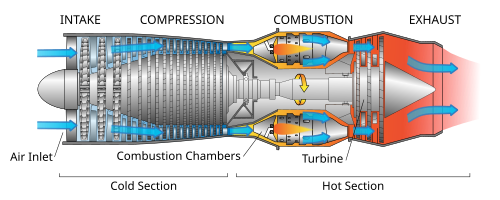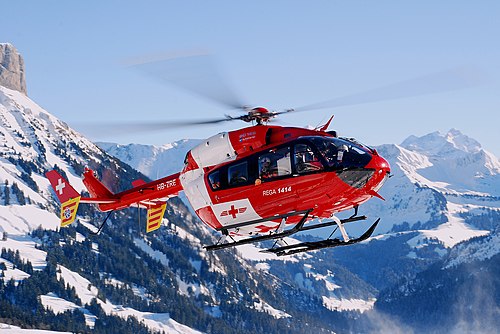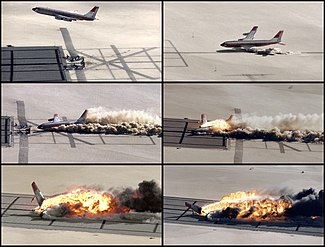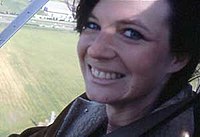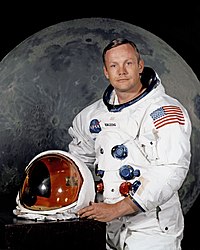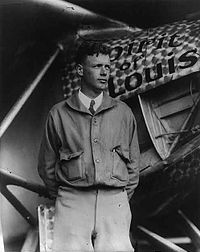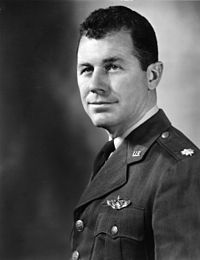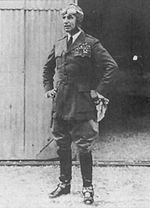Portal:Aviation: Difference between revisions
m Reverted edits by 84.56.4.177 (talk) to last version by 24.2.218.63 |
m +interwiki for no: |
||
| Line 75: | Line 75: | ||
[[ja:Portal:航空]] |
[[ja:Portal:航空]] |
||
[[nl:Portaal:Luchtvaart]] |
[[nl:Portaal:Luchtvaart]] |
||
[[no:Portal:Luftfart]] |
|||
[[pl:Portal:Lotnictwo]] |
[[pl:Portal:Lotnictwo]] |
||
[[ru:Портал:Авиация]] |
[[ru:Портал:Авиация]] |
||
Revision as of 10:59, 20 July 2007
| Main page | Categories & Main topics |
|
Tasks and Projects |
The Aviation Portal Aviation includes the activities surrounding mechanical flight and the aircraft industry. Aircraft includes fixed-wing and rotary-wing types, morphable wings, wing-less lifting bodies, as well as lighter-than-air craft such as hot air balloons and airships. Aviation began in the 18th century with the development of the hot air balloon, an apparatus capable of atmospheric displacement through buoyancy. Some of the most significant advancements in aviation technology came with the controlled gliding flying of Otto Lilienthal in 1896; then a large step in significance came with the construction of the first powered airplane by the Wright brothers in the early 1900s. Since that time, aviation has been technologically revolutionized by the introduction of the jet which permitted a major form of transport throughout the world. (Full article...) Selected articleSelected picture
Selected picturesUsage
Six F-16 Fighting Falcons with the U.S. Air Force Thunderbirds aerial demonstration team fly in delta formation in front of the Empire State Building during an air show. The F-16 Fighting Falcon is a modern multi-role jet fighter aircraft built in the United States. Designed as a lightweight fighter, it evolved into a successful multi-role aircraft, and is serving with 25 countries.
Coloured smoke reveals a vortex of air created by the wing of an airplane, also known as wake turbulence or jetwash. This turbulence can be especially hazardous during the landing and take off phases of flight, where an aircraft's proximity to the ground makes a timely recovery from turbulence-induced problems unlikely.
A cutaway digram of an aircraft hangar.
Wingtip vortices are visible trailing from an F-15E Strike Eagle as it disengages from midair refueling with a KC-10 Extender during Operation Iraqi Freedom.
 Credit: Clem Tillier An overlay diagram showing four of the largest wide-body aircraft ever built, the Hughes H-4 Hercules (the "Spruce Goose", aircraft with the greatest wingspan), the Antonov An-225 Mriya (the largest freight aircraft), the Boeing 747-8 Intercontinental (soon to be the largest version of the Jumbojet), and the Airbus A380-800 (the largest passenger aircraft).
 Credit: Master Sgt. Michael Ammons, USAF The F-15 Eagle is an American-built all-weather tactical fighter designed to gain and maintain air superiority in aerial combat. As of 2005, the F-15 in all air forces has a combined kill record of 104 confirmed kills to zero losses in air combat, although some F-15s have been claimed by surface-to-air missiles.
A squadron of C-17 Globemaster III airlifter aircraft on a low level tactical training mission over the Blue Ridge Mountains. The C-17 Globemaster III is used for rapid strategic airlift of troops and cargo to main operating bases or forward bases anywhere in the world. The aircraft carries on the name of two previous United States cargo aircraft, the C-74 Globemaster and the C-124 Globemaster II.
The airship USS Akron} flying over the southern tip of Manhattan circa 1931–1933. The Akron was a commissioned 'ship' of the United States Navy, built for them by the Goodyear Zeppelin Corporation in Akron, Ohio. She cast off for her maiden voyage on 2 November 1931, but crashed less than two years later.
 Credit: U.S. Air Force The first ejector seats were developed during the war by Heinkel. Early models were powered by compressed air and the first aircraft to be fitted with such a system was the Heinkel He 280 prototype jet fighter in 1941. One of the He 280 test pilots, Dipl.-Ing. Rudolf Schenk, flying for Argus, became the first person to escape from a stricken aircraft with an ejector seat on January 13, 1942. During a flight with the still engine-less V-1 towed by a Heinkel He 111 he had to leave his airplane because he could not release the towing cable due to icing of the coupling. By December 2003, Martin-Baker ejector seats had saved 7028 lives. The total figure for all types of seat is unknown but must be considerably higher.
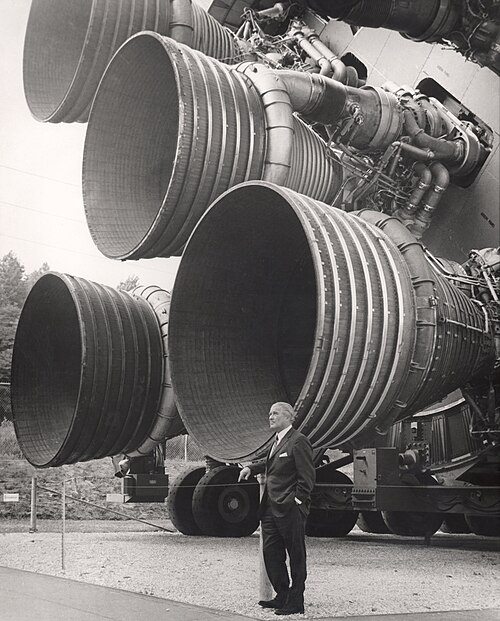 Credit: NASA A portrait of Wernher von Braun standing in front of the cluster of F-1 rocket engines on the base of the first stage of a Saturn V launch vehicle. Von Braun had a lifelong aspiration to fly to the moon. A pioneer of rocket development, in the Second World War von Braun led the German development of the V-2 rocket at Peenemünde. Along with his team of engineers, he surrendered to the American forces in the closing stages of the war, then helped to establish the military rocket program in the United States. In 1958 he transferred to the newly established NASA program, developing the Saturn V rocket that successfully delivered a man to the moon in 1969.
A C-141 Starlifter leaves vapour trails over Antarctica as it prepares for an airdrop during Operation Deep Freeze.
George Cayley's glider, created in 1853.
 Credit: Staff Sgt. Jeffrey Allen, USAF An F-15D Eagle from the 325th Fighter Wing based at Tyndall Air Force Base, Florida releasing flares. The F-15 is a multi-role tactical fighter designed by McDonnell Douglas. The first flight of the F-15A was in July 1972, but since then it has been produced in six model variations with both single seat and dual seat versions. The original and largest operator of the F-15 is the United States Air Force, but it is also operated by the air forces of Israel, Japan, Saudi Arabia and South Korea.
A French Gendarmerie rescue helicopter taking off on the Massif du Sancy mountains, France.
U.S. F/A-18 Hornet flying at transonic speeds. In aerodynamics, the sound barrier is a physical boundary that was once thought to be stopping large objects becoming supersonic. When an aircraft is near to the speed of sound, an unusual cloud sometimes forms. A drop in pressure, in this case due to shock wave formation, causes water droplets to condense and form the cloud.
San Francisco International Airport (IATA: SFO) opened on May 7, 1927 on 150 acres (607,000 m²) of cow pasture leased from prominent local landowner Ogden L. Mills, and was named Mills Field Municipal Airport. During the economic boom of the 1990s and the dot-com boom, SFO became the 6th busiest international airport in the world. However, since the boom times ended, it has fallen back out of the top twenty.
The planes that serve as Air Force One can be operated as a military command center in the event of an incident such as a nuclear attack. Operational modifications include aerial refueling capability, electronic countermeasures (ECMs) which jam enemy radar, and flares to avoid heat-seeking missiles. The heavily shieleded electronics onboard include around twice the amount of wiring found in a regular Boeing 747-200.
C-17 Globemaster III releasing a flare.
During a winch launch, a glider is pulled by a wire cable like a kite, raising it to an altitude of around 1000 ft (300 m). For the rest of its flight, being un-powered, the heavier-than-air aeroplane is always falling. However a pilot can gain height by circling within a strong thermal — a column of air that is rising at a faster rate than the plane is falling. On a good day, an experienced pilot can travel hundreds of miles before landing.
A B-1B Lancer drops back after air refueling training over the Pacific Ocean September 30. The B-1B is deployed to Andersen Air Force Base, Guam, as part of the Pacific Command's continuous bomber presence in the Asia-Pacific region, enhancing regional security and the U.S. commitment to the Western Pacific. The B1 is from the 28th Bomb Wing, Ellsworth AFB, South Dakota.
The Controlled Impact Demonstration was a joint project between NASA and the FAA in which a Boeing 720 was deliberately crashed in order to test the ability of the fuel additive FM-9, to inhibit the ignition and flame propagation of Jet-A fuel.
A pushback tractor attached to the front wheel of a Boeing 777. The vehicle is used to push the airplane out from the gate, before it starts taxiing on its own power. See Image:Denver International Airport, United Airlines Boeing 777 being serviced.jpg for a wider-view photo taken at the same time, from nearly the same angle.
The Northrop Grumman RQ-4 Global Hawk is an unmanned aerial vehicle (UAV) used by the US Air Force as a surveillance aircraft.
 Credit: Ericg An airfield traffic pattern is a standard path followed by aircraft when taking off or landing at an airport.The pattern (or circuit) is used to coordinate air traffic, and differs from straight-in approaches and departures in that aircraft remain in close proximity to the airport. Circuits are usually employed at small general aviation (GA) airfields and military airbases.
The Fairchild Republic A-10 Thunderbolt II is a single-seat, twin-engine jet aircraft designed to provide close air support of ground forces by attacking tanks, armored vehicles, and other ground targets. It is the first US Air Force aircraft designed exclusively for close air support.
The A-10 was developed in response to the increasing vulnerability of ground attack-planes to ground air defenses. This indicated the need for a specialized, heavily armored aircraft with long loiter time and large ordnance load, much like the Ilyushin Il-2 or A-1 Skyraider.
 Credit: User:Randyoo Hot air balloons are the oldest successful human flight technology, dating back to the Montgolfier brothers' invention in Annonay, France in 1783. The first manned flight was made in Paris by Pilâtre de Rozier and the Marquis d'Arlandes. Unmanned hot air balloons are mentioned in Chinese history. Chu-ko Kung-ming (諸葛 孔明) in the three kingdoms era used airborne lanterns for military signalling.
The Ryan X-13 Vertijet was designed to explore the feasibility of a pure-jet vertical takeoff and landing (VTOL) fighter aircraft. Here, the X-13 is about to moor itself to a dual-role flatbed transport/launch trailer.
A test firing of twin linear XRS-2200 Aerospike engines. The aerospike engine is a type of rocket engine that maintains its efficiency across a wide range of altitudes through the use of an aerospike nozzle.
A standard rocket engine uses a bell shaped nozzle to contain and direct the exhaust gases. However the optimum shape of the bell depends on the air pressure which reduces as the rocket climbs. An aerospike uses the air flowing past the rocket to form half of a 'virtual bell' which automatically compensates for the reducing pressure.
 Credit: Tech. Sgt. Ben Bloker (USAF) A P-51 Mustang in a heritage flight during an airshow at Langley Air Force Base, Virginia, USA. The P-51 was a long-range single-seat fighter aircraft that entered service with Allied air forces in the middle years of World War II. It remained in service with some air forces until the early 1980s.
A flight control system consists of the flight control surfaces, the respective cockpit controls, connecting linkage, and necessary operating mechanisms to control aircraft in flight.
An F/A-18C Hornet, assigned to the "Golden Dragons" of Strike Fighter Squadron One Nine Two (VFA-192), launches from the flight deck of the conventionally powered aircraft carrier USS Kitty Hawk (CV 63). Kitty Hawk and embarked Carrier Air Wing Five (CVW-5) are currently returning to their homeport after a scheduled deployment in the 7th Fleet area of responsibility.
A newsreel showing the breaking of the sound barrier on 14 October 1947 by Chuck Yeager in the rocket-powered Bell X-1. Flying at an altitude of 45,000 ft (13.7 km), Yeager became the first person to break the sound barrier in level flight.
Nevada test Site, August 7, 1957. The tail, or “After” section of a U.S. Navy Blimp is shown with the Stokes cloud in background. Blimp was in temporary free flight in excess of five miles from ground zero when collapsed by the shock wave from the blast. The airship was unmanned and was used in military effects experiments on blast and heat. Navy personnel on the ground in the vicinity of the experimental area were unhurt. On ground to the left are remains of the forward section.
Captain Joseph Kittinger steps from a balloon-supported gondola at the altitude of 102,800 feet (31.3 km), or almost 20 miles on August 16, 1960, as part of Project Excelsior, a series of high-altitude parachute jumps, testing a system that would allow a safe controlled descent after a high-altitude aircraft ejection. In freefall for 4.5 minutes at speeds up to 625 mph (1,005 km/h) and temperatures as low as −94°F (−70°C), he opened his parachute at 17,500 feet (5.3 km). The whole descent took 13 minutes and 45 seconds. This is the current world record for the highest parachute jump and was the longest freefall until Adrian Nicholas broke the record in 1998 with a wingsuit skydive lasting 4 minutes 55 seconds.
USAF aircraft of the 335th Fighter Squadron (F-16, F-15C and F-15E) fly over Kuwaiti oil fires, set by the retreating Iraqi army during Operation Desert Storm in 1991.
 Credit: NASA The Lockheed SR-71, commonly known as the "Blackbird," was an advanced, long-range, Mach 3 strategic reconnaissance aircraft that flew from 1964–98. The SR-71 was one of the first aircraft to be shaped to have an extremely low radar signature. The aircraft flew so fast and so high that if the pilot detected a surface-to-air missile launch, the standard evasive action was simply to accelerate. During its entire operational life, more than 3,000 missiles were fired at the aircraft, yet no SR-71 was ever shot down.
An attitude indicator (AI), gyro horizon or artificial horizon, is an instrument used in an aircraft to inform the pilot of the orientation of the airplane relative to earth.
Assembling B-25 bombers at North American Aviation -- Kansas City, Kansas; Reproduction from color slide
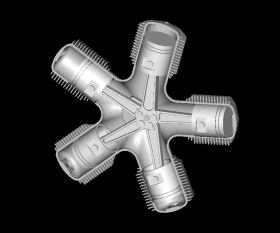 Credit: User:Duk Animation of a radial engine
 Credit: User:Jjron RAAF General Dynamics F-111 aircraft performing a dump-and-burn fuel dump. Avalon, Victoria, Australia.
 Credit: Sergey Kustov An Antonov An-124 belonging to Polet Airlines on final approach to Sheremetyevo International Airport in Moscow, Russia. The An-124 was designed for strategic lift capability and remains the third-largest operating cargo aircraft.
A SR-71 Blackbird three way view.
The inverted Jenny (or Jenny Invert) is a United States postage stamp of 1918 in which the image of the Curtiss JN-4 airplane in the center of the design was accidentally printed upside-down; it is probably the most famous error in American philately. Only 100 of the inverts were ever found, making this error one of the most prized in all philately; an inverted Jenny was sold at a Robert A. Siegel auction in June 2005 for US$525,000.
 Credit: Chowells A Supermarine Spitfire Mark XVI. The Spitfire was an iconic British single-seat fighter used by the RAF and many Allied countries in the Second World War. The Spitfire saw service during the whole of WWII in all theatres of war, and in many different variants. It is often credited with winning the Battle of Britain.
The UK Utterly Butterly display team perform an aerobatic maneuver with their Boeing Stearmans, at an air display in England.
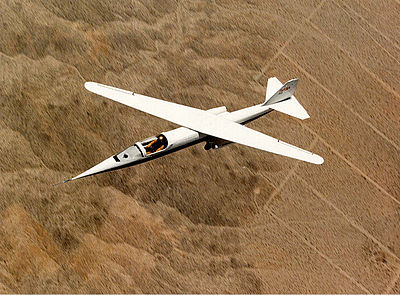 Credit: NASA Dryden Flight Research Center http://www1.dfrc.nasa.gov/Gallery/Photo/index.html The NASA AD-1 aircraft in flight with its wing swept at 60 degrees, the maximum sweep angle.
The Wright Flyer was the first powered aircraft designed and built by the Wright Brothers in 1903. It is generally considered to be the first successful powered, piloted aircraft.
In this photograph of the first flight at Kitty Hawk, North Carolina, Orville Wright is at the controls, lying prone on the lower wing with hips in the cradle that operated the wing warping mechanism. Wilbur Wright running alongside, has just released his hold to balance the machine.
A collection of aircraft at the National Air and Space Museum in Washington, D.C.
An F-14D Tomcat assigned to the "Tomcatters" of Fighter Squadron Three One (VF-31) sits poised for launch on one of four steam-powered catapults aboard the nuclear powered aircraft carrier USS John C. Stennis (CVN 74). Stennis and her embarked Carrier Air Wing One Four (CVW-14) are currently at sea conducting training exercises.
Flying a modified X-15A-2 in October, 1967, US Air Force Major William Joseph Knight reached Mach 6.72 (4,520 mph), which remains the highest speed ever attained in an airplane.
Schlieren photography (from the German word for "streaks") allows the visualization of density changes, and therefore shock waves, in fluid flow. Schlieren techniques have been used for decades in laboratory wind tunnels to visualize supersonic flow about model aircraft, but not full scale aircraft until recently. Dr. Leonard Weinstein of NASA Langley Research Center developed the first Schlieren camera, which he calls SAF (Schlieren for Aircraft in Flight), that can photograph the shock waves of a full sized aircraft in flight. He successfully took a picture which clearly shows the shock waves about a T-38 Talon aircraft on December 13, 1993 at Wallops Island, MD. The camera was then brought to the NASA Dryden Flight Research Center because of the high number of supersonic flights there.
 Credit: Fir0002 Cumulus clouds are characterized by dense individual elements in the form of puffs, mounds or towers, with flat bases and tops that often resemble cauliflower. They are formed due to convection. Buoyant, upward air currents, known as thermals rise to a height at which the moisture in the air can condense. Because of this, they "grow" vertically instead of horizontally. Though most common in warm, summer weather, cumulus clouds can be formed at any time of year.
Boeing-Stearman Model 75's. Taken in 1936 at NAS Pensacola during training of the first class of the Naval Aviation Cadet program. Photo includes Boone Guyton (plane in rear) who later became a test pilot for Chance-Vought (Vought Sikorsky) in 1939.
Crew members refuel an A V-22 Osprey before a night mission in central Iraq, Feb. 2, 2008.
A formation of F-4 Phantom II fighter aircraft fly in formation during a heritage flight demonstration here. The heritage flight program was established in 1997 to commemorate the 50th Anniversary of the U.S. Air Force.
Capt. Lowell H. Smith and Lt. John P. Richter performing the first aerial refueling on 27 June 1923. The Airco DH.4 biplane remained aloft over the skies of Rockwell Field in San Diego, California, for 37 hours. The airfield's logo is visible on the aircraft.
Lt. Col. James Hecker (front) and Lt. Col. Evan Dertein line up their F/A-22 Raptor aircraft behind a KC-10 Extender to refuel while en route to Hill Air Force Base, Utah. Colonel Hecker commands the first operational Raptor squadron -- the 27th Fighter Squadron at Langley Air Force Base, Va. The unit went to Hill for operation Combat Hammer, the squadron's first deployment, Oct. 15. The deployment has a twofold goal: complete a deployment and to generate a combat-effective sortie rate away from home.
English: 300 degree indoor panorama of baggage claim area at Hong Kong International Airport near midnight
 Credit: Dmitry A. Mottl Su-27 from Russian Knights aerobatic team on landing, Kubinka
1786 description of the historic Montgolfier Brothers' 1783 balloon flight. Illustration with engineering proportions and description.
Sequence of events leading to the collision between X - PSA 182 and ♦ - Cessna 172
Aircraft catapult officer, aka "Shooter" gives the signal to launch an FA-18 from a US aircraft carrier.
An F/A-18 makes an arrested landing aboard a US aircraft carrier.
This JRF-5 Grumman JRF-5 Goose was assigned to Naval Air Station Jacksonville, Florida (USA), in 1941 and remained on the station throughout the Second World War. Only one of these aircraft flew from the station and was used for utility purposes, including photography.
 Credit: Luigi Rados Sophie Blanchard, French Balloonist. Ascent of August 15th 1811 at Milan. Full-length portrait of French balloonist Marie-Madeleine-Sophie Armand Blanchard, standing in the decorated basket of her balloon during her flight in Milan, Italy, in 1811, in the presence of the imperial and royal highness.
Photo credit: Bain News Service Hélène Dutrieu, shown here in her aeroplane ca. 1911, was the fourth woman in the world (the first from Belgium) to earn a pilot's license and reputedly the first woman to carry passengers and to fly a seaplane. Besides being a pilot, she was a cycling world champion, stunt cyclist, stunt motorcyclist, automobile racer, wartime ambulance driver, and director of a military hospital.
 Credit: USAF Convair B-36 with experimental tracked landing gear, to reduce ground pressure for soft-field use.
 Credit: U.S. Air Force photo/Staff Sgt. Samuel Rogers [1] Capt. Matt Buckner, an F-15 Eagle pilot assigned to the 71st Fighter Squadron at Langley Air Force Base, Va., flies a combat air patrol mission Oct. 7 over Washington, D.C., in support of Operation Noble Eagle.
 JetBlue Airways Flight 292, an Airbus A320-232, making an emergency landing at LAX on September 21, 2005 after the front landing gear malfunctioned. The front gear was turned perpendicular to the runway causing the tires to be torn off and sparks to fly up on impact. No one was injured during the landing and passengers began to disembark less than seven minutes later.
Inside of a hot air balloon
 Credit: User:Mfield Los Angeles Police Department (LAPD) Bell 206 Jetranger helicopter
The Blue Angels use a United States Marine Corps C-130T Hercules, nicknamed "Fat Albert", for their logistics, carrying spare parts, equipment, and to carry support personnel between shows. Beginning in 1975, "Bert" was used for Jet Assisted Take Off (JATO) and short aerial demonstrations just prior to the main event at selected venues, but the JATO demonstration ended in 2009 due to dwindling supplies of rockets.
Diagram: Jeff Dahl A diagram of a typical turbojet engine. Air is compressed as it enters the engine, and is mixed with fuel that burns in the combustion section. Released through the exhaust, the resulting hot gases provide forward thrust and turn the turbines that drive the fan blades of the compressor.
 Refueling a fire fighting helicopter Southern River, Western Australia. The Royal Australian Air Force (RAAF) Roulettes aerobatics squadron at the 2008 Australian Grand Prix. The squad was formed in 1970 to celebrate the 50th anniversary of the RAAF and perform about 150 flying displays a year throughout Australia and neighboring countries.
Second World War Recruiting poster
Swiss rescue helicopter in action.
An F-22 Raptor flies over Kadena Air Base, Japan, Jan. 23 on a routine training mission. The F-22 is deployed from the 27th Fighter Squadron at Langley Air Force Base, Va.
A T-45A Goshawk executes a turning rejoin during a recent formation flight over South Texas. The T-45 is a twin-seat, single-engine jet trainer and is the only aircraft in the Navy's inventory used specifically for training pilots to land aboard aircraft carriers.
A Polish Yakovlev Yak-18; Góraszka Air Picnic 2008
The Let L-410 Turbolet is a twin-engined short-range transport aircraft, manufactured by the Czech aircraft manufacturer LET, mostly used for passenger transport. The L-410 first flew in 1969, and with more than 1100 produced, is the most popular 19-seat plane in history.
 Credit: Mila Zinkova A Bell 212 Twin Huey carrying a helicopter bucket, a specialized bucket suspended on a cable to deliver water for helitack operations, which is aerial firefighting using helicopters. Helitack crews are used to attack a wildfire and gain early control of it, especially when inaccessibility would make it difficult or impossible for ground crews to respond in the same amount of time.
 Credit: Image credit: Fastfission A schematic of the V-2 rocket, the first ballistic missile, the first man-made object to achieve sub-orbital spaceflight, and the progenitor of all modern rockets. Developed by Wernher von Braun on behalf of Nazi Germany, and based on work by Robert H. Goddard, over 3,000 V-2s were launched during World War II against Allied targets, resulting in the death of an estimated 7,250 military personnel and civilians. An estimated 20,000 inmates at Mittelbau-Dora died constructing V-2s, making the V-2 perhaps the only weapon system to have more deaths caused by its production than its deployment.
On December 1, 1984, NASA and the Federal Aviation Administration (FAA) conducted the Controlled Impact Demonstration, where they deliberately crashed a Boeing 720 aircraft with the intent of improving occupant crash survivability. Seen left-to-right, top-to-bottom, the plane makes a practice approach, hits the ground, slides for a short distance, strikes posts cemented in the ground, and becomes engulfed in flames.
Picture: Sergey Kustov The Airbus A330 is a wide-body twin-engine jet airliner made by Airbus which was introduced in 1994. The A330-200, such as pictured here in Aeroflot livery, entered service in 1998 and was considerably more popular than the earlier A330-300. In December 2012 there were 476 A330-200s in operation.
Credit: NASA An F/A-18 Hornet performs an automated aerial refueling operation on another. This was part of a study by the Dryden Flight Research Center to evaluate the ability of the F/A-18 as an in-flight refueling tanker to develop analytical models for an automated aerial refueling system for unmanned aerial vehicles. The project is documenting how an operational tanker's drogue basket responds when in the presence of the receiver aircraft.
 Composite image showing multiple stages of a Monarch Jet aircraft taking off from the Gibraltar Airport.
JF-17 at the IDEAS 2008 defence exhibition in Karachi, Pakistan
Selected Biography
Selected biographyUsageThe layout design for these subpages is at Portal:Aviation/Selected biography/Layout.
Despite her surname, Jeana Yeager is not related to Chuck Yeager, the first man to break the sound barrier in level flight. Air Commodore Sir Frank Whittle (1 June 1907 – 9 August 1996) was a Royal Air Force officer and was one of the inventors of jet propulsion. By the end of the war, Whittle's efforts resulted in engines that would lead the world in performance through the end of the decade.Born in Earlsdon, Coventry, England on June 1, 1907, Whittle left Leamington College in 1923 to join the Royal Air Force (RAF). Through his early days as an Aircraft apprentice he maintained his interest in the Model Aircraft Society where he built replicas, the quality of which attracted the eye of his commanding officer, who was so impressed that he recommended Whittle for the Officer Training College at Cranwell in Lincolnshire in 1926, a rarity for a "commoner" in what was still a very class-based military structure. A requirement of the course was that each student had to produce a thesis for graduation. Whittle decided to write his thesis on future developments in aircraft design, in which he described what is today referred to as a motorjet. Whittle and Hans von Ohain met after the war and initially Whittle was angry with him as he felt Ohain had stolen his ideas. Ohain eventually convinced him that his work was independent and after that point the two became good friends. Elbert Leander "Burt" Rutan (born June 17, 1943 in Estacada, Oregon) is an American aerospace engineer noted for his originality in designing light, strong, unusual-looking, energy-efficient aircraft. He is most famous for his design of the record-breaking Voyager, which was the first plane to fly around the world without stopping or refueling, and the suborbital rocket plane SpaceShipOne, which won the Ansari X-Prize in 2004. Elizabeth 'Bessie' Coleman (January 26, 1892 – April 30, 1926), popularly known as "Queen Bess", was the first African American (male or female) to become an airplane pilot, and the first American of any race or gender to hold an international pilot license. Growing up in Chicago, she heard tales of the world from pilots who were returning home from World War I. They told stories about flying in the war, and Coleman started to fantasize about being a pilot. She could not gain admission to American flight schools because she was black and a woman. No black U.S. aviator would train her either. Coleman took French language class at the Berlitz school in Chicago, and then traveled to Paris on November 20, 1920. Coleman learned to fly in a Nieuport Type 82 biplane. Neil Armstrong (born August 5, 1930) is a former American astronaut, test pilot, university professor, and United States Naval Aviator. He was the first person to set foot on the Moon. His first spaceflight was aboard Gemini 8 in 1966, for which he was the command pilot. On this mission, he performed the first manned docking of two spacecraft together with pilot David Scott. Armstrong's second and last spaceflight was as mission commander of the Apollo 11 moon landing mission on July 20, 1969. On this mission, Armstrong and Buzz Aldrin descended to the lunar surface and spent 2.5 hours exploring while Michael Collins orbited. Armstrong is a recipient of the Congressional Space Medal of Honor.Before becoming an astronaut, Armstrong was in the United States Navy and saw action in the Korean War. After the war, he served as a test pilot at the National Advisory Committee for Aeronautics (NACA) High-Speed Flight Station, now known as the Dryden Flight Research Center, where he flew over 900 flights in a variety of aircraft. As a research pilot, Armstrong served as project pilot on the F-100 Super Sabre A and C aircraft, F-101 Voodoo, and the Lockheed F-104A Starfighter. He also flew the Bell X-1B, Bell X-5, North American X-15, F-105 Thunderchief, F-106 Delta Dart, B-47 Stratojet, KC-135 Stratotanker and Paresev. He graduated from Purdue University. Charles Augustus Lindbergh, Jr. (February 4, 1902 – August 26, 1974), known as "Lucky Lindy" and "The Lone Eagle", was a pioneering United States aviator famous for piloting the first solo non-stop flight across the Atlantic Ocean in 1927, flying from Roosevelt Airfield (Nassau County, Long Island), New York to Paris on May 20-May 21, 1927 in his single-engine aircraft The Spirit of St. Louis.He grew up in Little Falls, Minnesota. Early on he showed an interest in machinery, especially aircraft. After training as a pilot with the Army Air Service Lindbergh took a job as lead pilot of an airmail route in a DeHavilland DH-4 biplane. He was renowned for delivering the mail under any circumstances. Lindbergh is recognized in aviation for demonstrating and charting polar air-routes, high altitude flying techniques, and increasing aircraft flying range by decreasing fuel consumption. These innovations are the basis of modern intercontinental air travel. Charles Elwood "Chuck" Yeager (born February 13, 1923) is a retired Brigadier-General in the United States Air Force and a noted test pilot. In 1947, he became the first pilot (at age 24) to travel faster than sound in level flight and ascent.His career began in World War II as a private in the U.S. Army Air Forces. After serving as an aircraft mechanic, in September 1942 he entered enlisted pilot training and upon graduation was promoted to the rank of Flight Officer (WW 2 U.S. Army Air Forces rank equivalent to Warrant Officer) and became a P-51 Mustang fighter pilot. After the war he became a test pilot of many kinds of aircraft and rocket planes. Yeager was the first man to break the sound barrier on October 14, 1947, flying the experimental Bell X-1 at Mach 1 at an altitude of 45,000 ft (13,700 m). Although Scott Crossfield was the first man to fly faster than Mach 2 in 1953, Yeager shortly thereafter exceeded Mach 2.4.[2] He later commanded fighter squadrons and wings in Germany and in Southeast Asia during the Vietnam War, and in recognition of the outstanding performance ratings of those units he then was promoted to Brigadier-General. Yeager's flying career spans more than sixty years and has taken him to every corner of the globe, even into the Soviet Union during the height of the Cold War.  The Reverend John Flynn (25 November 1880 – 5 May 1951) was an Australian Presbyterian minister and aviator who founded the Royal Flying Doctor Service, the world's first air ambulance. Throughout his ministerial training, Flynn had worked in various then-remote areas through Victoria and South Australia. As well as tending to matters spiritual, Flynn quickly established the need for medical care for residents of the vast Australian outback, and established a number of bush hospitals. By 1917, Flynn was already considering the possibility of new technology, such as radio and the aeroplane, to assist in providing a more useful acute medical service, and then received a letter from an Australian pilot serving in World War I, Clifford Peel, who had heard of Flynn's speculations and outlined the capabilities and costs of then-available planes. Flynn turned his considerable fund-raising talents to the task of establishing a flying medical service. The first flight of the Aerial Medical Service was in 1928 from Cloncurry. In 1934 the Australian Aerial Medical Service was formed, and gradually established a network of bases nationwide. Flynn remained the public face of the organisation (through name changes to its present form) and helped raise the funds that kept the service operating. Amelia Mary Earhart (July 24, 1897 – missing as of July 2, 1937), daughter of Edwin and Amy Earhart, was an American aviator and noted early female pilot who mysteriously disappeared over the Pacific Ocean during a circumnavigational flight in 1937.By 1919 Earhart had enrolled at Columbia University to study pre-med but quit a year later to be with her parents in California. Later in Long Beach she and her father went to a stunt-flying exhibition and the next day she went on a ten minute flight. Earhart had her first flying lesson at Kinner Field near Long Beach. Her teacher was Anita Snook, a pioneer female aviator. Six months later Earhart purchased a yellow Kinner Airster biplane which she named "Canary". On October 22, 1922, she flew it to an altitude of 14,000 feet, setting a women's world record. After Charles Lindbergh's solo flight across the Atlantic in 1927, Amy Guest, a wealthy American living in London, England expressed interest in being the first woman to fly (or be flown) across the Atlantic Ocean, but after deciding the trip was too dangerous to make herself, she offered to sponsor the project, suggesting they find "another girl with the right image." While at work one afternoon in April 1928 Earhart got a phone call from a man who asked her, "Would you like to fly the Atlantic?" 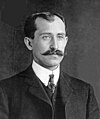  The Wright brothers, Orville Wright (August 19, 1871 - January 30, 1948) and Wilbur Wright (April 16, 1867 - May 30, 1912), are generally credited with making the first controlled, powered, heavier-than-air flight on December 17, 1903. In the two years afterward, they developed their flying machine into the world's first practical airplane, along with many other aviation milestones. In 1878 Wilbur and Orville were given a toy "helicopter" by their father. The device was made of paper, bamboo and cork with a rubber band to twirl its twin blades, and about a foot long. The boys played with it until it broke, then built their own. In later years, they pointed to their experience with the toy as the initial spark of their interest in flying. Amy Johnson (1 July 1903 – 5 January 1941) C.B.E. was a pioneering British aviatrix. Born in Kingston upon Hull, Johnson graduated from University of Sheffield with a Bachelor of Arts in economics. She was introduced to flying as a hobby, gaining a pilot's A Licence No. 1979 on 6 July 1929 at the London Aeroplane Club. In that same year, she became the first British woman to gain a ground engineer's C License. Johnson achieved worldwide recognition when, in 1930, she became the first woman to fly solo from England to Australia. She left Croydon on 5 May of that year and landed in Darwin, Australia on 24 May after flying 11,000 miles. Her aircraft for this flight, a De Havilland Gipsy Moth (registration G-AAAH) named Jason, can still be seen in the Science Museum in London. She received the Harmon Trophy as well as a CBE in homage to this achievement, and was also honoured with the No. 1 civil pilot's licence under Australia's 1921 Air Navigation Regulations. In July 1931, Johnson and her co-pilot Jack Humphreys became the first pilots to fly from London to Moscow in one day, completing the 1,760-mile journey in approximately 21 hours. From there, they continued across Siberia and on to Tokyo, setting a record time for flying from England to Japan. The flight was completed in a De Havilland Puss Moth. Air Marshal Sir George Jones KBE, CB, DFC (18 October 1896 – 24 August 1992) was a senior commander in the Royal Australian Air Force (RAAF). He rose from being a private soldier in World War I to Air Marshal in 1948. He served as Chief of the Air Staff from 1942 to 1952, the longest continuous tenure of any RAAF chief. Jones was a surprise appointee to the Air Force’s top role, and his achievements in the position were coloured by a divisive relationship during World War II with his head of operations and nominal subordinate, Air Vice Marshal William Bostock.Jones first saw action as an infantryman in the Gallipoli campaign of 1915, before transferring to the Australian Flying Corps the following year. Initially an air mechanic, he undertook flying training in 1917 and was posted to a fighter squadron in France, achieving seven victories to become an ace. After a short spell in civilian life following World War I, he joined the newly-formed RAAF in 1921, rising steadily through training and personnel commands prior to World War II. He did not actively seek the position of Chief of the Air Staff before being appointed in 1942, and his conflict with Bostock—with whom he had been friends for 20 years—was partly the result of a divided command structure, which neither man had any direct role in shaping. After World War II Jones had overall responsibility for transforming what was then the world's fourth largest air force into a peacetime service that was also able to meet overseas commitments in Malaya and Korea. Following his retirement from the RAAF he continued to serve in the aircraft industry and later ran unsuccessfully for political office. Sophie Blanchard (25 March 1778 – 6 July 1819) was a French aeronaut and the wife of ballooning pioneer Jean-Pierre Blanchard. Blanchard was the first woman to work as a professional balloonist, and after her husband's death she continued ballooning, making more than 60 ascents. Known throughout Europe for her ballooning exploits, Blanchard entertained Napoleon Bonaparte, who promoted her to the role of "Aeronaut of the Official Festivals", replacing André-Jacques Garnerin. On the restoration of the monarchy in 1814 she performed for Louis XVIII, who named her "Official Aeronaut of the Restoration".Ballooning was a risky business for the pioneers. Blanchard lost consciousness on a few occasions, endured freezing temperatures and almost drowned when her balloon crashed in a marsh. In 1819, she became the first woman to be killed in an aviation accident when, during an exhibition in the Tivoli Gardens in Paris, she launched fireworks that ignited the gas in her balloon. Her craft crashed on the roof of a house and she fell to her death. She is commonly referred to as Madame Blanchard and is also known by many combinations of her maiden and married names, including Madeleine-Sophie Blanchard, Marie Madeleine-Sophie Blanchard, Marie Sophie Armant and Madeleine-Sophie Armant Blanchard. Erich Alfred "Bubi" Hartmann (19 April 1922 – 20 September 1993), also nicknamed "The Blond Knight of Germany" by friends and "The Black Devil" by his enemies, was a German fighter pilot and still is the highest scoring fighter ace in the history of aerial combat. He scored 352 aerial victories (of which 345 were won against the Soviet Air Force, and 260 of which were fighters) in 1,404 combat missions and engaging in aerial combat 825 times while serving with the Luftwaffe in World War II. During the course of his career Hartmann was forced to crash land his damaged fighter 14 times. This was due to damage received from parts of enemy aircraft he had just shot down, or mechanical failure. Hartmann was never shot down or forced to land due to enemy fire.[3] Hartmann, a pre-war glider pilot, joined the Luftwaffe in 1940 and completed his fighter pilot training in 1942. He was posted to Jagdgeschwader 52 (JG 52) on the Eastern front and was fortunate to be placed under the supervision of some of the Luftwaffe's most experienced fighter pilots. Under their guidance Hartmann steadily developed his tactics which would earn him the coveted Knight's Cross of the Iron Cross with Oak Leaves, Swords and Diamonds on 25 August 1944 for claiming 301 aerial victories. He scored his 352nd and last aerial victory on 8 May 1945. He and the remainder of JG 52 surrendered to United States Army forces and were turned over to the Red Army. Convicted of false "War Crimes" and sentenced to 25 years of hard labour, Hartmann would spend 10 years in various Soviet prison camps and gulags until he was released in 1955. In 1956, Hartmann joined the newly established West German Luftwaffe and became the first Geschwaderkommodore of Jagdgeschwader 71 "Richthofen". Hartmann resigned early from the Bundeswehr in 1970, largely due to his opposition of the F-104 Starfighter deployment in the Bundesluftwaffe and the resulting clashes with his superiors over this issue. Erich Hartmann died in 1993. Elizabeth Muriel Gregory "Elsie" MacGill (27 March 1905 – 4 November 1980), known as the Queen of the Hurricanes, was the world's first female aircraft designer. She worked as an aeronautical engineer during the Second World War and did much to make Canada a powerhouse of airplane construction during her years at Canada Car and Foundry (CC&F) in Fort William, Ontario. After her work at CC&F she ran a successful consulting business. Between 1967–1970 she was a commissioner on the Royal Commission on the Status of Women in Canada, published in 1970. Billy Mitchell (1879–1936) was an early aviation pioneer who rose to become a chief of the U.S. Army Air Service. Mitchell was born in Nice, France and raised on his family estate near Milwaukee, Wisconsin. He attended George Washington University before enlisting in the Army at age 18 during the Spanish–American War. Due to his family connection he quickly received a commission Signal Corps where he had the opportunity to witness a flight demonstration by the Wright brothers in 1908. In 1916 he took private flight lessons and was transferred to the Aeronautical Division.Mitchell deployed to France in 1917 when the United States entered World War I. While there he was promoted to brigadier general and placed in command American combat air units in France. After the war Mitchell was appointed the deputy director of the Air Service became a passionate advocate of air power. In 1921 he set up a demonstration to show the capability of airpower against naval vessels. During the course of the demonstrations aircraft successfully sank a captured German destroyer, the light crusier Frankfurt, and the battleship Ostfriesland. Mitchell regularly sparred with his superiors over the role of airpower in the military. In 1925 he was reverted to his permanent rank of colonel and was transferred to San Antonio, Texas. Later that year, after a series of aviation accidents he accused Army and Navy leadership of incompetence and "almost treasonable administration of the national defense." In response he was court-martialed for insubordination, found guilty, and sentenced to a five-year suspension from active duty. Mitchell resigned on 1 February 1926 in lieu of serving the sentence. He continued to advocate airpower as a civilian until his death in 1936. In 1942 President Franklin Roosevelt posthumously promoted Mitchell to major general in recognition of his contributions to air power. Francis Stanley "Gabby" Gabreski (Franciszek Gabryszewski) (28 January 1919 - January 31, 2002) was the top American fighter ace in Europe during World War II, a jet fighter ace in Korea, and commanded numerous fighter squadrons, groups, and wings during his Air Force career.Assigned as a P-40 pilot with the 45th Fighter Squadron of the 15th Fighter Group at Wheeler Field, Hawaii, 2nd Lt. Gabreski witnessed the Japanese attack on Pearl Harbor, but did not become airborne in time to engage the attackers. In March 1943 Gabreski became part of the 56th Fighter Group, flying the P-47 Thunderbolt, and in May was promoted to Major and named commander of the 61st Fighter Squadron, which included six Polish nationals as pilots in 1944. He made his 28th kill on July 5, 1944, passing Eddie Rickenbacker's record from World War I to become America's top ace (although several pilots passed him by the end of the war). Col. Gabreski flew combat again during the Korean War, as commander of the 51st Fighter-Interceptor Wing, piloting an F-86 Sabre. He was credited with 6.5 MiG-15 kills, making him one of seven U.S. pilots to be aces in more than one war (the others are Col. Harrison Thyng, Col. James P. Hagerstrom, Major William T. Whisner, Col. Vermont Garrison, Major George A. Davis, Jr., and Lt.Col. John F. Bolt, USMC). He ended his career as a commander of several tactical and air defense wings, his last assignment being commander of the 52d Fighter Wing at Suffolk County Air Force Base in Westhampton Beach, New York. Benjamin Delahauf Foulois (1879-1967) was an early aviation pioneer who rose to become a chief of the U.S. Army Air Corps. The son of a French immigrant, he was born and raised in Connecticut. He enlisted in the Army at age 18 to serve in the Spanish–American War. After just a few month he was separated because of disease he had picked up in Puerto Rico. He re-enlisted in 1899 and was sent to the Philippines where he received a commission as a Second Lieutenant. Foulois believed that the new airplane would replace the cavalry for reconnaissance and in 1908 transferred into the Signal Corps.Foulois conducted the acceptance test for the Army's first aircraft, a Wright Model A, in 1909. He participated in the Mexican Expedition from 1916–17 and was part of the American Expeditionary Force in France during World War I where he was responsible for the logistics and maintenance of the U.S. air fleet. During World War I he and Billy Mitchell began a long and hostile relationship over the direction of military aviation and the best method to get there. After the war he served as a military attaché to Germany where he gathered a great deal of intelligence on German aviation. He later went on to command the 1st Aero Squadron and ultimately commanded the Air Corps. He retired in 1935 as part of the fallout from the Air Mail scandal. Foulois continued to advocate for a strong air service in retirement. In 1959, at the invitation of the Chief of Staff of the Air Force, Foulois began touring Air Force bases advocating national security. He died of a heart attack on 25 April 1967 and is buried in his home town of Washington, Connecticut. Marshal of the Royal Air Force Hugh Montague Trenchard, 1st Viscount Trenchard GCB OM GCVO DSO (3 February 1873 – 10 February 1956) was a British officer who was instrumental in establishing the Royal Air Force. He has been described as the Father of the Royal Air Force.During his formative years Trenchard struggled academically, failing many examinations and only just succeeding in meeting the minimum standard for commissioned service in the British Army. As a young infantry officer, Trenchard served in India and in South Africa. During the Boer War, Trenchard was critically wounded and as a result of his injury, he lost a lung, was partially paralysed and returned to Great Britain. While convalescing in Switzerland he took up bobsleighing and after a heavy crash, Trenchard found that his paralysis was gone and that he could walk unaided. Some months later, Trenchard returned to South Africa before volunteering for service in Nigeria. During his time in Nigeria, Trenchard commanded the Southern Nigeria Regiment for several years and was involved in efforts to bring the interior under settled British rule and quell inter-tribal violence. In 1912, Trenchard learned to fly and was subsequently appointed as second in command of the Central Flying School. He held several senior positions in the Royal Flying Corps during World War I, serving as the commander of Royal Flying Corps in France from 1915 to 1917. In 1918, he briefly served as the first Chief of the Air Staff before taking up command of the Independent Air Force in France. Returning as Chief of the Air Staff under Winston Churchill in 1919, Trenchard spent the following decade securing the future of the Royal Air Force. He was Metropolitan Police Commissioner in the 1930s and a defender of the RAF in his later years. Helmut Paul Emil Wick (5 August 1915 – 28 November 1940) was a German Luftwaffe ace and the fourth recipient of the Knight's Cross of the Iron Cross with Oak Leaves (German: Ritterkreuz des Eisernen Kreuzes mit Eichenlaub). The Knight's Cross of the Iron Cross and its higher grade, the Oak Leaves, was awarded by the Third Reich to recognise extreme bravery in battle or successful military leadership. It was Germany's highest military decoration at the time of its presentation to Helmut Wick.Born in Mannheim, Wick joined the Luftwaffe in 1936 and was trained as a fighter pilot. He was assigned to Jagdgeschwader 2 "Richthofen" (JG 2—2nd Fighter Wing), and saw combat in the Battles of France and Britain. Promoted to Major in October 1940, he was given the position of Geschwaderkommodore (wing commander) of JG 2—the youngest in the Luftwaffe to hold this rank and position. He was shot down in the vicinity of the Isle of Wight on 28 November 1940 and posted as missing in action, presumed dead. By then he had been credited with destroying 56 enemy aircraft in aerial combat, making him the leading German fighter pilot at the time. Flying the Messerschmitt Bf 109, he claimed all of his victories against the Western Allies. Portal:Aviation/Selected biography/28 Portal:Aviation/Selected biography/29 Portal:Aviation/Selected biography/30 Portal:Aviation/Selected biography/31 Portal:Aviation/Selected biography/32 Portal:Aviation/Selected biography/33 Portal:Aviation/Selected biography/34 Portal:Aviation/Selected biography/35 Portal:Aviation/Selected biography/36 Portal:Aviation/Selected biography/37 Portal:Aviation/Selected biography/38 Portal:Aviation/Selected biography/39 Portal:Aviation/Selected biography/40 Portal:Aviation/Selected biography/41 Portal:Aviation/Selected biography/42 Portal:Aviation/Selected biography/43 Portal:Aviation/Selected biography/44 Portal:Aviation/Selected biography/45 Portal:Aviation/Selected biography/46 Portal:Aviation/Selected biography/47 Portal:Aviation/Selected biography/48 </noinclude> Did you know...that the pioneer American airman Lowell Smith participated in the first mid-air refueling, the first aerial circumnavigation and held 16 records for military aircraft in speed, endurance and distance? Today in Aviation
References
Selected AircraftRelated portalsAssociated WikimediaThe following Wikimedia Foundation sister projects provide more on this subject:
|




